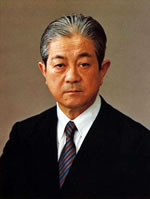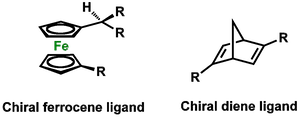This interview series has been around for a few months now, and has received many positive reviews. We appreciate your encouragement and we would like to continue this series. For this 8th interview, we followed Professor Takeshi Kitahara’s suggestion (from interview #3) and interviewed Professor Tamio Hayashi at Kyoto University (note added for translated version: Prof. Hayashi was interviewed while he was at Kyoto University, but he is currently at the National University of Singapore). Professor Hayashi has synthesized many chiral ligands and has reported numerous transition-metal-catalyzed asymmetric reactions over the course of his career. He is one of the leaders of the field of catalytic asymmetric reactions and his contributions represent a national pride—in 2010, he was awarded the very prestigious Purple Ribbon Medal of Honor from the Government of Japan. Please read on to find out more about this exceptional scientist.
[su_dropcap size=”2″]Q[/su_dropcap] What made you choose chemistry as a career?
[su_dropcap size=”2″]A[/su_dropcap]
I have already answered this question on many interviews before, but most of them were answered jokingly; herein, I will reveal a different, more serious, answer. Somehow, I had been accepted to the Department of Synthetic Chemistry in the Faculty of Engineering at Kyoto University. My gloomy high school days revolved around studying and more studying in order to get accepted into university. I had no spare time or strength to think about what I really wanted to study in the future. I was satisfied as long as I was accepted into university. But as it turns out, my daily life in synthetic chemistry was a lot of fun. Even my experiments in my junior (3rd) year—those that are conducted with fully anticipated results—were fun.
In my senior (4th) year, I was assigned to a laboratory, where I was blessed with great professors (Professors Makoto Kumada, Keiji Yamamoto, Mitsuo Ishikawa, Kohei Tamao, among others), great senior students, and great research projects, all of which made my experience in the laboratory enjoyable. I love observing chemical phenomena, and in synthetic organic chemistry, one can observe drastic changes in a fairly short amount of time—I think the nature of chemical experiments and my personality matched quite well. After that, well, I happened to stay in the same university for some time, and after studying chemistry for over 10 years, people started to call me a “chemist”—although I hadn’t fully realized it at the time, I guess there is no other way to call me!
[su_dropcap size=”2″]Q[/su_dropcap]
If you were not a chemist, what would you like to be, and why?
[su_dropcap size=”2″]A[/su_dropcap]
Not that I want to be one, but I feel that I would have been successful as a surgeon. I am confident in manipulating things at the tips of my fingers and in taking key decisions in any situation. As for what I wanted to be—I wanted to be a sailor. In my senior (4th) year of university, I was in the university yacht club. Listening to the waves crashing onto the vessel made me happy.
[su_dropcap size=”2″]Q[/su_dropcap]
Currently, what kind of research are you conducting? Moreover, how do you foresee its future development?
[su_dropcap size=”2″]A[/su_dropcap]
I develop highly selective organic chemistry transformations using transition metal catalysis. A recent achievement from my research group is an asymmetric catalytic reaction using chiral diene ligands. Dienes, of which a representative member is cyclooctadiene, can accelerate some rhodium-catalyzed reactions more than phosphine ligands. Chiral dienes can render such transformations asymmetric. There are still many discoveries to be made using this concept. I would like to tackle more research problems using chiral dienes, but I will soon face mandatory retirement at Kyoto University, so I wonder how far I can get.
[su_dropcap size=”2″]Q[/su_dropcap]
If you could have dinner with any famous person from the past, who would it be, and why?
[su_dropcap size=”2″]A[/su_dropcap]
This may be an unusual response, but Cleopatra. Although Cleopatra has not been positively described in Nanami Shiono’s “Res Gestae Populi Romani” (Stories of the Romans), I am certain that Cleopatra must have displayed some sort of charm. Older sis’ Cleopatra (I would somehow imagine her as being slightly older, about 5 years older) and a 35-year-old me would have a relaxed dinner talking about anything and everything—food likes and dislikes, what happened during the day, and so on.
[su_dropcap size=”2″]Q[/su_dropcap]
When was the last time you performed an experiment in the laboratory, and what was it about?
[su_dropcap size=”2″]A[/su_dropcap]
Last year (2009), in December, I was in Guangzhou, China, at Sun Yat-sen University. I showed a local student how to recrystallize an optically active phosphine ligand that is prone to air oxidation. My last real experiment in the laboratory must have been around 1990, when I was at the Catalysis Research Center in Hokkaido University. I synthesized a chiral ferrocenylphosphine that had a new substituent on it.
[su_dropcap size=”2″]Q[/su_dropcap]
If you were stranded on a desert island, which book or song/piece of music would you like to have with you? Please single out your favorite example.
[su_dropcap size=”2″]A[/su_dropcap]
If I really had to go to a desert island right now, I would bring Haruki Murakami’s “Hard-Boiled Wonderland and the End of the World.” It’s not that I particularly like Haruki Murakami. It’s just that I recently started reading it, and it’s kind of hard to really get absorbed by this book at the beginning, but it’s finally starting to get interesting, so I really have to finish the book now. As for one song, I would choose the “Sunshine of your love” by the British rock band “Cream.” I listen to it a lot on my drive to work. If this kept running on replay all day, how would that feel? Probably not too bad!
[amazonjs asin=”B000002GFC” locale=”US” title=”The Very Best of Cream”]
[su_dropcap size=”2″]Q[/su_dropcap] Do you have any suggestions as to whom we should interview next?
[su_dropcap size=”2″]A[/su_dropcap]
Since Professor Kitahara suggested me as an interviewee, I understand that this series of chemists involves slightly older professors. I would like to suggest professors that are close to 70 but are still at the forefront of research—specifically Professors Motokazu Uemura and Junzo Otera—before they pass away.
[su_box title=”Biographical sketch of Tamio Hayashi:” style=”bubbles”]Professor Tamio Hayashi is a Professor at the Graduate School of Science in Kyoto University. He obtained his Ph. D. in 1975 from the Department of Synthetic Chemistry in the Faculty of Engineering at Kyoto University. He became an Assistant in the same university, before moving onto the Catalysis Research Center in Hokkaido University in 1989. Thereafter, in 1994, he moved back to Kyoto to occupy the position that he holds today. His long list of awards includes the IBM Japan Science Prize (1991), the Chemical Society of Japan Award (2002), the Ryoji Noyori Prize (2007), the Arthur C. Cope Scholar Award (2008), and the Purple Ribbon Medal of Honor (2010).[/su_box]
Japanese version written here on Nov 29, 2010 ; English translation written on May 18, 2014.



